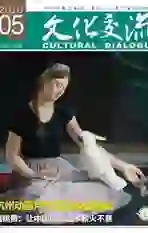水印文化:传承千年的东方智慧
2018-05-09张侃诚
张侃诚
“水印千年——中国水印版画大展”日前在浙江美术馆展出。
中国是版画艺术的发祥地,早在汉代就出现了用版画漏印法在织物上制作的工艺布版画,此后从用墨汁和水质颜料印刷的古代水印木刻到汲取了传统版画、民族绘画、民间美术精华的现代水印创作,无不鲜明地体现出中华民族意境自然的艺术特色与东方文化含蓄隽永的美学品格。
水印版画作为发端于中国的一门独特技艺,从隋代木刻刊刻至今的1400多年的历史演变始终承载着东方社会独有的内生视野和记忆感觉,深刻蕴含着中国的东方美学精神。
直观呈现东方文化“水”性内涵
杭州与水印艺术的渊源已逾越千年,得天独厚的自然环境和深远的人文内蕴与之血脉相契。“水印千年——中国水印版画大展”,通过“版刻千秋——中国传统水印版画”“汲古镌今——中国现当代水印版画”“东方意蕴——中国木版年画与浮世绘”“湖山胜概——西湖主题水印版画”“拓山印湖——公共艺术项目”五个篇章观照“水印版画”这一古老却又新意十足的艺术。展览力图整合日常与经典、庙堂与自然、诗意与谨严、真实与奇幻、私人与公众、体验与程式、传统与现代、原始与未来等丰富维度构建起当代水印时空,以图像、文字、实物、影音、公共活动等多种创作样式,探索边界、发掘水印文化的美学生命力,直观呈现东方文化“水”性内涵的魅力。
“水印千年”大展也是浙江美术馆“东方智慧”系列展览的开端。系列展以“东方智慧”为元点,以5年左右时间展开一场“向西归东”的精神之旅,即通过2016—2018年的“水印千年”、2019年的“纸上谈缤”、2020年的“山海經”,在“东方视野”之中,整体呈现“形态叙事——认知拓展——精神溯源”的主旨延展,来探索、复兴和呈现深蕴其中的中华民族智慧历久弥新的活力。
从“版刻千秋”到“拓山印湖”
大展第一板块“版刻千秋”以代表性的古典版画图像、大型雕版实物装置作品以及古籍文献呈示水印艺术的演进历程,为整个大展提供一个悠远的时间背景。
展品包括汉传、藏传以及西夏时期的不同经卷,意在反映传播的广远性。各类古籍插图中最具中国传统人文内涵和审美成就最高的部分还属明清时期小说、传奇,这些精美而富含情节意味的插图既是传统智慧和民间技艺的结晶,在世俗生活的流播过程中又对建构我们民族的审美意趣和价值导向产生了深刻久远的影响。此外,还特别选取陈洪绶《西厢记·窥简》一图为蓝本,以动漫、影像手段进行活化再造,挖掘历史图像的表现潜力,探寻古今图像传播和接受方式的内在关联。随着传统水印技艺的不断精进,“书画仿制”体系也应运而生,从历代各类书画谱发展到后世以书画仿制见长的“荣宝斋”“朵云轩”专营机构,再到以技艺传承和艺术创作实践为主旨的“紫竹斋”(中国美术学院)等院校工作室,构成了与当代水印的审美和技艺发展历程最为切近的发展脉络,此类作品也一并纳入其中。
“汲古镌今”板块以各地区水印名家的代表性作品展现1950年至2000年间中国现代水印版图概貌,并借此梳理中华人民共和国成立后,现代水印技艺的生成、迁播、流变的历史。其中,特别推出数位中生代艺术家专题,通过他们各自有代表性思维和创作方式,呈现水印艺术历久弥新、柔韧而强大的内在精神。
“东方意蕴”板块,展示中日两国具有代表性、元素相互影响的转换阶段作品,借此唤起人们对东方古国共通的文化精神及其生命力的认识。
在中国民间传统年画部分,除能见到杨柳青、桃花坞、漳州等各个地区典型作品外,还有一部分“半印半绘”样式的展品,如山东扑灰年画等。与人们熟知的节庆画那种热烈吉祥的审美追求有所不同的是,这部分展品在形制、题材等方面鲜明体现人伦教化功能或是文人绘画意趣,呈现出民俗民间与书画元素的融合状态,反映了传统水印技艺在历史发展中具有的丰富可能性和强大的实践力。中日两国一衣带水,有着悠久的文化交流历史,典型的日本浮世绘即是在接受中国水印版画技艺的影响的基础上形成了独特的发展面貌。同时,作为一种市井风情型的绘画样式,日本浮世绘与我国民间年画等民俗版画在传播效应和呈现样态上有相当的可比性。
2016年8月,浙江美术馆成功策划并实施了“湖山胜概——‘水印千年启动展”。在展陈语言和内容方面都进行了一些突破性的尝试,将新颖的陈设手段融景观、历史、文化与传统技艺于一体,不仅观照于古今西湖的历史变迁,更形象化地凝练了西湖的诗意特质。

“湖山”为历代文人对杭州城市空间诗意精神的形象概括。“拓山印湖”用中国传统碑拓技艺中的标志性手段——“印”与“拓”,择取历史人文遗迹丰富的吴山和西湖水域的经典景观构成“湖山”现场。艺术家以大地为版、自然为版、时间为版,以各种人文印迹与自然造物为素材,拓历史、拓万物,拓众生、拓天下。从形态而言,它与画作形成了相宜的动静关系;从观念而言,与启动展“湖山胜概”形成呼应,“见山还是山”。
“拓山印湖”的静态成果是展览的重要组成部分,而媒体介入和现场互动的过程也成为一个公共文化事件。通过公众在地体验的方式,唤起参与者对中国美学血脉、文化精神的再认识。观众可以通过展览体验到水印文化所内蕴的“东方智慧”,它既可以具体到一个技巧动作,一个精微的局部、一幅画面,又可以是浩大的,直接关涉一个文化领域、一方天地。
水印大展的走出去和引进来
“湖山勝概”被文化部评为2016年全国美术馆8个优秀展览项目之一,先后得到了日本、德国及我国香港特区等地艺术机构的认可和邀约。通过2016年到2017年期间“湖山胜概”展的推进实践,对当代文化建构语境下传统叙事的思考也日渐清晰。事实证明,地域和历史问题并非当代中国展览走向世界的关键阻滞,展览的国际性和当代性需要更恰当的策展思维来实现。“拓山印湖”的在地项目还将随着展览持续流动至各地,如“一带一路”沿线国家等,在世界各地陆续实施。
同时,本次展览引入日本浮世绘作品,诸如有“浮世绘三杰”之称的葛饰北斋、安藤广重和喜多川歌麻吕等当世顶尖画师们。通过一系列的艺术鉴赏与交流,研究对比中国传统技艺的变迁与发展,从而认同民族文化,不断丰富民族文化,发展先进文化,传承中华民族的传统美德。
From January 19 to March 11, 2018, Zhejiang Museum of Art held a large-scale exhibition highlighting watercolor printmaking in China. It was a really grand exhibition, featuring exhibits in eight spacious halls. The exhibition endeavored to provide an ambitious review of watercolor printmaking on the world: time results in the prints of history, nature creates the prints of everything and the earth gives birth to the prints of the material and spiritual world.
Watercolor printmaking originated in China. The earliest example of this ancient art can be traced to the Han Dynasty (202BC-220AD). The prints of about 20 centuries ago are on textiles. The earliest woodblock print on paper is a religious artwork discovered in Dunhuang, a key outpost on the Silk Road in northwestern China. It was dated in 607AD in the Sui Dynasty (581-618) and the colors were added after the print was done. It is over 1,400 years old. The artwork is now in a collection of Harvard Art Museums.
Watercolor printmaking in China has evolved over the millennia and absorbed elements from other art genres. Through all the changes, the art unmistakably carries and embodies the worldview, self-understanding, aesthetics, memories and senses of the Chinese people.
It is worth mentioning that Hangzhou where Zhejiang Art Museum is situated boasts a long history of watercolor printmaking. In the last decades of the Tang (618-907) and the Five Dynasties (907-960), Hangzhou emerged as the nations principal book printer. The woodblock printing and publishing industry transformed the city. In the Southern Song Dynasty (1127-1279), woodblock printing thrived in this city where the imperial house of the dynasty lived for about 150 years. The flourishing printers in the city employed quite a few woodblock engravers and illustrators. In the Ming (1368-1644) and the Qing (1644-1911), illustrators in Hangzhou pushed the art to a new high and left a huge and legendary legacy to the city.
The exhibition was in five sections. The first section traced the genesis and evolution of watercolor printmaking in China, as testified by prints, woodcut installations, and ancient books on display. This section included printed copies of Buddhism scriptures in Chinese and Tibetan as well as those printed in the Western Xia (1038-1227), all made with the woodblock printing technology. These books indicated how far woodblock printing traveled and helped culture flourish across the vast land. Also in this section were illustrations of ancient novels and theater scripts. Moreover, this section featured the watercolor prints made by contemporary studios to show how artists of today are absorbing the elements of the past and how they are carrying the tradition to the future.
The second section included masterpieces dated from 1950 to 2000. These works represented the best by prominent printmakers across the country in the last five decades of the 20th century, showing how the ancient art evolved in the fifty years of ups and downs. In particular, a small number of representative artists of this period were highlighted.
The third section highlighted the traditional Chinese New Year prints as well as
Ukiyo-e prints by top Japanese artists such as Katsushika Hokusai, Ando Hiroshige and Kitagawa Utamaro. Ukiyo-e in Japan, translated as pictures of the floating world, evolved from the Chinese watercolor printmaking and morphed into a unique style. The rationale behind the juxtaposition of the traditional Chinese New Year prints and Ukiyo-e prints in this section at the exhibition was that the two were largely comparable in contents, presentation, and distribution.

The fourth section presented the landscape prints portraying the West Lake, a legendary scenic tourist destination of Hangzhou since very ancient times. This section was actually a prelude, done in August 2016 at Zhejiang Art Museum, to the exhibition from January to March of this year. The prints highlighted the changes the West Lake experienced in ancient times and today and portrayed the poetic beauty of the lake and its places of historical and cultural interests. This independent exhibition was recognized as one of the countrys top eight museum events of 2016 by the Ministry of Culture. The exhibition, titled Landscape Highlights of the West Lake, has been staged in Japan, Germany and Hong Kong SAR.
The fifth section displayed rubbings and prints. Most of these rubbings were from inscriptions displayed at scenic and historical spots of the West Lake and the city itself. Visitors could also try their hands at doing a rubbing or printing a piece.
